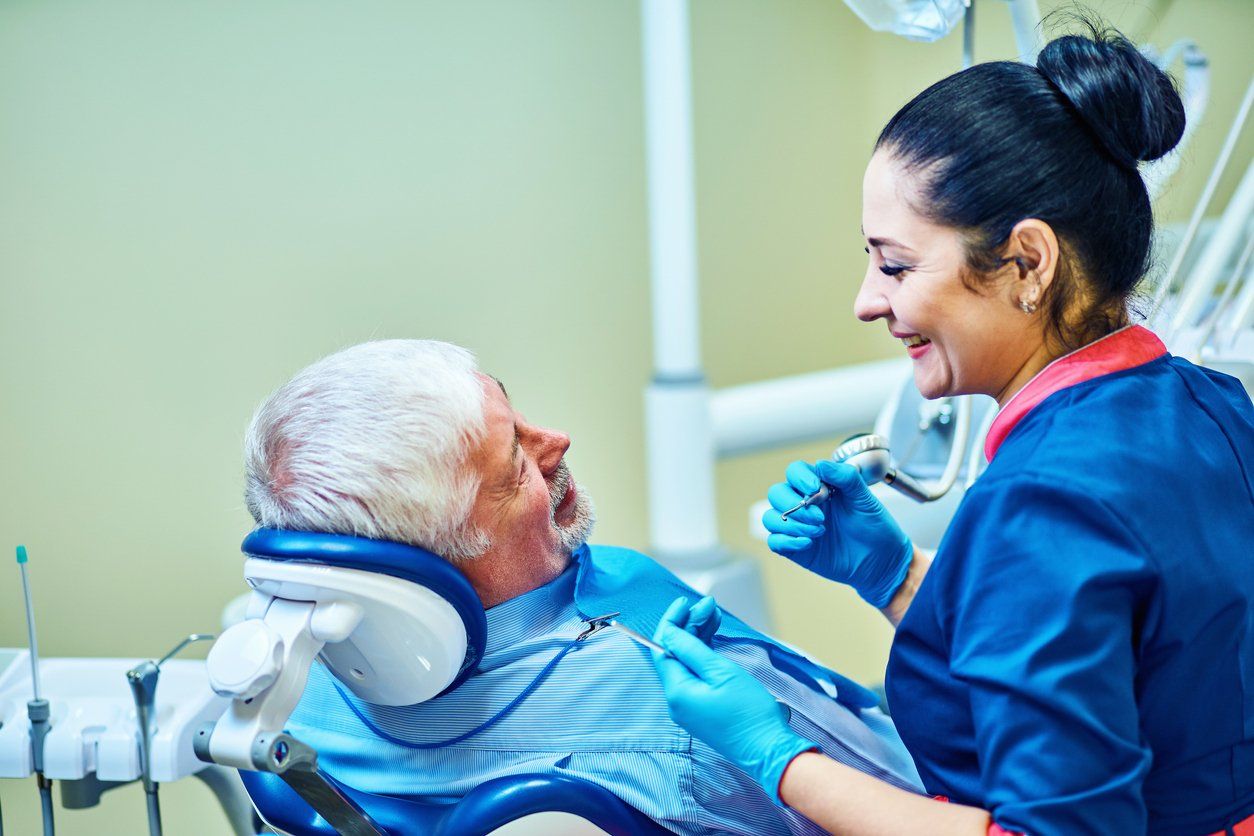Blog Layout
Why Do I Need Dental X-Rays?
Apr 05, 2019
Standard dental exams help ensure your oral health. A dental exam allows your dentist to give tips on minding to your teeth and to distinguish any issues early when they’re generally treatable. Standard dental exams are a critical piece of preventive health care. A dental exam, the dentist or hygienist will clean your teeth and check for depressions and gum sickness. The dentist or hygienist will likewise assess your danger of creating other oral health issues, like check your face, neck, and mouth for variations from the norm. A dental exam may likewise incorporate dental X-rays (radiographs) or other demonstrative methods.
Also, the dentist or hygienist will probably talk about your eating regimen and oral cleanliness and might show legitimate brushing and flossing strategies. Different subjects for dialog may incorporate a way of life factors that can influence oral health and conceivable corrective enhancements to your teeth.
Amid a dental exam, the dentist or hygienist will:
•Evaluate your general health and oral cleanliness•Evaluate your danger of tooth rot, root rot, and gum or bone infection•Evaluate your requirement for tooth reclamation or tooth substitution•Check your chomp and jaw for issues•Remove any stains or stores on your teeth•Demonstrate appropriate cleaning procedures for your teeth or dentures•Assess your requirement for fluoride•Take dental X-rays or, if essential, do other indicative methodology
Amid a dental exam, your dentist will likewise get some information about any health issues you have or medications you’re taking and talk about how they may influence your oral health. Due to diabetes, for example, you’re at expanded danger of gum infection. Any medication that adds to dry mouth can build your danger of tooth rot. If joint inflammation meddles with your capacity to viably brush your teeth, your dentist or hygienist may tell you the best way to embed the handle of your toothbrush into an elastic ball for less demanding use or suggest a fuelled or oscillating brush.
If you have prosthetic substitutions, for example, dentures or extensions — your dentist or hygienist will examine how well they fit and talk about the requirement for changes. Dental exams may likewise incorporate directing about eating regimen, utilization of tobacco items and another way of life factors that can influence oral health.
Dental X-ray
X-rays, otherwise called radiographs, are a fundamental piece of any dental consideration treatment plan. They are analytic, however, they can likewise be preventive, by helping a dentist analyse potential oral consideration issues in a patient’s mouth before they turn into a noteworthy issue. Dental X-rays (radiographs) are pictures of your teeth that your dentist uses to assess your oral health. These X-rays are utilized with low dimensions of radiation to catch pictures of the inside of your teeth and gums. This can assist your dentist with identifying issues, similar to cavities, tooth rot, and affected teeth. Dental X-rays may appear to be complex. However, they’re exceptionally regular apparatuses that are similarly as vital as your teeth cleanings.
Why Dental X-rays Are Performed
Dental X-rays are regularly performed yearly. They can happen all the more regularly if your dentist is following the advancement of a dental issue or treatment.
Elements influencing how regularly you get dental X-rays may include:
•Your age•Your current oral health•Any indications of oral infection•History of gum ailment (gum disease) or tooth rot
In case you’re another patient, you’ll likely experience dental X-rays with the goal that your new dentist can get a reasonable image of your dental health. This is particularly imperative on the off chance that you don’t have any X-rays from your past dentist.
Kids may need dental X-rays more frequently than grown-ups because their dentists may need to screen the development of their grown-up teeth. This is critical because it can enable the dentist to decide whether child teeth should be pulled to anticipate intricacies, for example, grown-up teeth developing in behind the infant’s teeth.
Dangers of Dental X-rays
While dental X-rays do include radiation, the exposed dimensions are low to the point that they’re viewed as safe for kids and grown-ups. On the off chance that your dentist utilizes computerized X-rays as opposed to creating them on film, your dangers from radiation exposure are even lower.
Your dentist will likewise put a lead “tucker” over your chest, stomach area, and pelvic district to keep any superfluous radiation exposure to your essential organs. A thyroid neckline might be utilized on account of thyroid conditions. Kids and ladies of childbearing age may likewise wear them alongside the lead kiddie apron.
Pregnancy is an exception to the standard. Women who are pregnant or trust they might be pregnant ought to keep away from a wide range of X-rays. Tell your dentist on the off chance that you trust you are pregnant because radiation isn’t viewed as safe for creating babies.
Getting Ready For Dental X-rays
Dental X-rays require no extraordinary readiness. That makes a progressively sterile condition for those working inside your mouth. X-rays are normally done before cleanings.
At the dentist’s office, you’ll sit in a seat with a lead vest over your chest and lap. The X-ray machine is situated close by your head to record radiograph of the mouth. Some dent has a different space for X-rays, while others perform them in the indistinguishable room from cleanings and different strategies.
TYPES OF DENTAL X-RAYS
A dental X-beam enables the dentist to see itemized pictures of your mouth. Different kinds of dental X-rays are accessible, including:
•Bitewing. This sort of X-beam enables the dentist to see the crowns of the upper and lower teeth. Amid a bitewing X-beam, you’ll chomp down on the X-beam film holder while the X-beam pictures are being taken. Every X-beam demonstrates the upper and lower molars (back teeth) and bicuspids (teeth before the molars). These X-rays are classified “nibble wings” since you clench down on a wing-formed gadget that holds the film set up while the X-beam is taken. These X-rays enable dentists to discover rot between back teeth.•Periapical. This sort of X-beam enables the dentist to see the whole tooth and the encompassing bone. A periapical X-beam seems to be like a chomp wing X-beam. Be that as it may, it demonstrates the whole length of every tooth, from crown to root. This incorporates each tooth, from crown to attach to supporting structures. They are X-rayed utilizing both bitewing and periapical radiographs.•Occlusal. This sort of X-ray enables the dentist to see the way the upper teeth and relating lower teeth fit together when the jaw is close. They are bigger than most X-rays. They feature tooth advancement and position in youngsters. Every X-beam indicates the full curve of teeth in either the upper or lower jaw.•Cephalometric projections are X-rays taken of the whole side of the head. They are utilized to take a gander at the teeth in connection to the jaw and the individual’s profile. Orthodontists use cephalometric projections to decide the best sort of orthodontic treatment.•Panoramic. This sort of X-beam gives the dentist an expansive perspective of the whole mouth. Panoramic X-rays show the whole mouth on a solitary X-beam. They incorporate all teeth on both upper and lower jaws. This sort of X-beam requires an exceptional machine. The cylinder head that discharges the X-rays hovers behind your head while the film hovers over the front. That way, the full, expansive perspective of the jaws is caught on one film. Since the machine moves in a set way, you must be situated cautiously. Gadgets joined to the X-beam machine hold your head and jaw set up. This may look and feel threatening. However, the procedure is protected. It frequently utilizes less radiation than intraoral X-rays.•Cone beam modernized tomography. This kind of X-beam gives a 3-D see so the dentist can more readily measure the separating of teeth and contiguous structures. Cone-beam processed tomography (CT) gives three-dimensional pictures. You stand or sit while the machine pivots around your head. The beam is cone-formed, rather than fan-moulded as in a standard therapeutic CT. A cone-beam check utilizes less radiation than a restorative CT examine however unquestionably more than any standard dental X-beam. The cone-beam CT is especially helpful for dental implant determination and situation.•Standard processed tomography (CT) typically should be done in a radiologist’s office or an emergency clinic. Commonly, you will rest while the picture is taken. The radiation exposure is higher for this sort of CT than for a cone-beam CT. A standard CT sweep might be done to decide the size and position area for implants.•Digital radiographs are one of the most up to date X-beam methods. Standard X-beam film is supplanted with a level electronic cushion or sensor. The picture goes into a PC, where it tends to be seen on a screen, put away or printed out. Computerized X-rays taken at various occasions can be analysed utilizing a procedure that features contrasts between the pictures. Little changes along these lines can be gotten before. Utilized appropriately, advanced X-rays use about a large portion of the radiation of ordinary film.
X-rays aren’t normally required at each dental visit. Radiation exposure from dental X-rays is drastically low — yet converse with your dentist in case you’re worried about radiation exposure.
HOW X-RAYS ARE USED
X-ray pictures are among the most significant instruments a dentist has for keeping your mouth and teeth healthy. They are additionally called dental radiographs.
For grown-ups, dental X-rays are utilized to:
•Look for regions of rot that the dentist will most likely be unable to see just by looking, for example, rot between teeth•Look for rot under a filling•Look for splits or other damage in a filling•Alert the dentist to conceivable bone misfortune from periodontal (gum) illness•Show issues in the foundation of a tooth, for example, disease or demise of the nerve•Help your dentist plan, get ready and spot tooth implants, supports, dentures or other dental work•Look for different issues.

18 Sep, 2019
However, some young children need early intervention or Phase One treatment. This evaluation doesn’t necessarily mean orthodontics are needed right away. However, monitoring growth patterns can indicate the best opportunity to start treatment to get the best results. The American Association of Orthodontists recommends that your child has an initial screening at the age of seven, with formal orthodontics beginning around age nine. What Causes Orthodontic Problems? Some cases may be a matter of genetics or inherited orthodontic issues such as crowded teeth, excessive spacing, bad bites, or protruding teeth. Other cases may be due to injury, early or late loss of baby teeth, or habits like thumb sucking. Evaluating the Need for Early Treatment Some issues are easy to diagnose, and some developmental issues can correct themselves as children grow into their preteen years. It is important to have a professional determine if your child’s oral development is on track or if they need intervention. Some of the issues a dentist may evaluate include: Difficulty chewing or biting Thumb sucking after age five Mouth breathing Speech impediments Early or late loss of baby teeth Protruding teeth Shifting of the jaw when opening or closing (cross-bite) Crowded front teeth What is Phase One Treatment? The goal of early treatment is to help your child’s jaw to develop correctly, so there is plenty of room for their permanent. Partial braces, palatal expansion, space maintainers, or retainers can all be used to create more space and improve bone growth. These early intervention methods can help eliminate the need for corrective surgery later on and make regular orthodontic procedures shorter and more effective. Phase one treatment typically lasts about 10-14 months. Once it is complete, your child will be fitted with a retainer to keep everything in place until it is time to move on to phase two, then the next phase will begin around age 11 or older, after all, permanent teeth have erupted. Phase Two Orthodontic Treatment Once most of your child’s permanent teeth have erupted (around age 11 or older), phase two can begin. Most cases that require phase one treatment will also require a phase two. The second phase usually requires full braces or clear aligners and can begin once the 12-year molars are close to erupting. The braces or aligners will need to be carefully monitored for about 18-24 months. After this treatment is complete, a retainer will still need to be worn every night to prevent teeth from moving back to their original position. Simplify Orthodontics with Early Intervention Orthodontics, like most other dental and medical services are best used as a preventive measure. Beginning orthodontic treatment early can prevent the development of problems for your child in later years and can stave off costly restorative and reconstructive procedures. Early treatment may not apply to all orthodontic problems, but it can help in certain cases. Braces have improved dramatically over the past couple of decades, making them more comfortable and more effective. With proper planning, a child who has early orthodontics may enjoy better self-confidence, optimal tooth and bite function, improved tooth and jaw alignment, and more stable results.

18 Sep, 2019
DIY Whitening Toothpaste If you are a DIY fan, making your own toothpaste from baking soda and hydrogen peroxide can be highly effective and economical. Mix together one-part hydrogen peroxide and two parts baking soda for a bargain toothpaste that costs less than three dollars! If you want a ready to go option, look for a product in the super-market isle that contains these ingredients. The most important element here is to brush regularly, often, and with a soft toothbrush. To really step up your brushing game invest in an electric toothbrush. Not only do they remove plaque and stimulate gums better, but they also have timers to make sure you are brushing long enough. Whitening Mouth Rinses Before and After Brushing For a full rounded whitening routine, pre-rinse, floss, brush, then use mouthwash. The active ingredients in mouthwash loosen up buildup and food to make brushing and flossing more effective. A mouthwash after brushing gets into any gaps you’ve missed the first go around and allows the fluoride to soak into the enamel. A mouthwash that contains hydrogen peroxide and used at least twice a day for three months can significantly whiten teeth. Word of caution: avoid mouthwashes that are dark in color; the color can actually stain your teeth when the alcohol evaporates. Most companies who develop these products suggest a daily usage cycle of approximately twelve weeks in order to see expected results. Over-the-Counter Whitening Strips & Gels Whitening strips are extremely thin strips that are typically coated with a peroxide-based stain removal gel. Usually, you can expect initial results after a few days of use, with more complete results showing up after approximately four months of regular usage. Whitening gels can also be applied with an application brush directly to the surface of the teeth. The application directions will vary dependent upon the strength of the peroxide used in the particular tooth whitening product. Some dental experts suggest that whitening mouthwashes may not be quite as effective as other over the counter products because the mouthwash is only in direct contact with your teeth for as little as sixty seconds, whereas other products remain in contact with the enamel longer. For example, many tooth whitening strips suggest an application of 30 minutes or longer, or 60 times as long as a typical mouth rinse application. Due to this much shorter application cycle, mouth rinses may have less of a pronounced effect than other competing options. You may consider using a tooth whitening mouth rinse in addition to one or more of the other solutions rather than instead of them. This could provide a better result than using the mouth rinse product by itself. Tray-Based Whitening Systems Another tooth whitening option you might want to consider is the tray-based whitening system. These systems can be purchased either from your dentist or over-the-counter. They typically involve a mouth guard shaped tray and a tooth whitening solution that contains a peroxide enamel gel. Some pricier brands even use ultraviolet light to speed up the process. You generally wear this tray for a specified period of time ranging from a couple of hours per day to overnight. The directions may call for wearing this tray for the specified time daily for four weeks or longer, depending upon how discolored your teeth are and how many shades of whitening you desire. Professional Whitening Treatments Many dental offices offer professional in-office whitening treatment solutions. These solutions can often provide the quickest and most effective results relative to the other products listed in this article. However, they can also be the most expensive. Even with the improved effectiveness of professional dental office whitening solutions, you may still need multiple treatments to achieve the results you desire, so keep that in account when considering going with this option. Dental office treatments usually involve a whitening product that is applied directly to the teeth. The whitening solution is often combined with heat, light, or laser treatment as well. You can expect to see results in a single half-hour to one-hour treatment. To achieve more dramatic results, repeated appointments are often needed. The biggest advantage of going with a professional office treatment is that you can usually see results after one treatment, so if you need results quickly, this is often the best way to go, despite the higher price tag. The better you feel about your teeth, the more effort you will put into its care and maintenance. Whether you choose to go with toothpaste, gels, strips, rinses or dental office treatment, having whiter teeth can provide an excellent boost to personal confidence and improve the way you feel about your overall appearance and oral health.

11 Sep, 2019
Dental phobia prevents you from receiving the routine treatment you need to maintain the health and functionality of your smile. Sedation dentistry can help you get the care you need by providing a relaxing experience with significantly less anxiety. Sedatives can include anti-anxiety medications, tranquilizers, nitrous oxide, and depressants, all administered in a variety of ways by an experienced professional for an effective solution to combat this common phobia. Popular Kinds of Sedation Dentistry In the past, IV or intravenous sedation was the predominant method used to sedate a patient. Today we have access to more advanced techniques that are simple and easy and don’t require needles. Sedation treatment is sometimes called sleep dentistry, but it does not make you sleep during your procedure. The effects of the sedatives will make you feel sleepy, and in some cases, you forget the entire experience as if you slept through the visit. Oral Sedatives: This is the most common technique used in the United States and Canada. Oral sedatives include drugs such as Diazepam and are taken about one hour before the start of your scheduled dental appointment to allow the drugs to take effect in your system. You generally remain awake for the duration of your dental appointment but feel considerably more relaxed and less anxious than you would have without the medication. You will maintain consciousness during your treatment, allowing you to cooperate with your dentist safely. Intravenous Sedatives: This type of sedative are administered via an IV or intravenous injection directly into the bloodstream.They put you into a deep state of relaxation, allowing you to rest until the procedure is complete. This sedative can put you into a “twilight sleep,” a state in which you remain conscious, but feel sleepy and remember little if any of the procedure. Nitrous Oxide: This is an inhaled gas that helps you to relax during your dental procedure and wears off fairly quickly. For this reason, your dentist may allow you to drive yourself home after the treatment is over, and the effects have worn off fully. Choosing the Right Option for You It may be tempting to assume that IV sedation would be best because it provides the deepest form of relaxation. This sedation must be administered and monitored by someone specifically trained, and some dentists only offer it for specific procedures. You’ll need to evaluate all your options before simply choosing a general anesthetic option. Some sedation options can raise your threshold for pain, but most dental procedures will still require the injection of a local anesthetic. Fortunately, you won’t notice the injection much if you are already relaxed before the injection. This prevents you from experiencing any pain and can make the whole experience a lot easier to handle. Who Can Benefit from Sedation Dentistry? People have a variety of reasons for preferring sedation dentistry, including: You have a general anxiety disorder that causes you to experience anxiety during daily life, including dental visits. You have a specific phobia about dental procedures or dentists. You have had bad experiences with dental procedures in the past, leading to discomfort around dental treatment now. You have a smaller mouth than most people, which affects the ability of dentists to reach the back molars and tissue during procedures. You have especially sensitive oral nerves. You have a resistance to local anesthetics like Novocain or Benzocaine which causes them to be ineffective on you. If you are affected by any of these, talk to your dentist about sedation dentistry. Using sedation dentistry, your dental care provider can make it easier for you to receive important treatments such as fillings, extractions, root canal therapy, dental implants, crowns, bridges, and more. It’s unlikely you will need dental sedation if you are just receiving a simple tooth cleaning, dental x-ray, or tooth whitening procedure. If you experience a great deal of anxiety around these procedures, however, you may be an exception and be allowed to use dental sedation for routine visits.

09 Sep, 2019
A cavity that is left without proper treatment can get worse and eventually grow deeper into the tooth, reach the nerve and causing great pain and even more significant damage. These remedies can help to provide some relief and support your oral health. Oil of Oregano to Stop Decay Some people have achieved good results by using Oil of Oregano as a natural antiseptic to prevent tooth decay. A study in 2008 discovered that one of the naturally occurring compounds found in Oregano had strong antimicrobial properties. You can brush with Oil of Oregano daily to help slow the growth of cavities and prevent further tooth decay from forming. Establish a Healthy pH Level with Xylitol Xylitol is a natural sweetener which can help to prevent the spread of bacteria and prevent tooth decay. For these reasons, it is often used as an ingredient in toothpaste. Xylitol is derived from plant fibers and can break down sugar to keep the pH levels in your mouth neutral. It also helps to stop bacteria in the mouth from emitting the acid that causes tooth decay and cavities, while also making it more difficult for these bacteria to stick to the teeth, gums, and other areas inside the mouth. Clove Oil for Pain Relief and Prevention Cloves are an established natural remedy to treat toothache. Use a cotton swab to apply one or two drops of the oil directly on the spot of the tooth cavity and allow it to soak in. Clove oil has been used often before the modern advances of dental methods to treat both the pain of a cavity and to restore enamel. The oil produces a numbing effect to combat pain and can help your tooth retain minerals. You can apply it every two to three hours as needed or add a few drops to a teaspoon of coconut oil and swirl it around in your mouth. Neem Bark to Fight Infection You can brush with Neem sticks or chew on the leaves or seeds to destroy cavity-causing bacteria. The powerful oil in this plant has a long history as a remedy for oral infections, tooth decay, and for preventing bleeding and sore gums. All over India Neem twigs are used as chewing sticks to reduce oral bacteria and naturally clean and whiten teeth and even fight bad breath. Green Tea as a Natural Fluoride Treatment Drinking (unsweetened, or at least sugar-free) Green Tea daily can help to eliminate harmful bacteria buildup in your mouth. Green Tea contains a decent amount of naturally occurring fluorine which acts as a decay preventative. You can even use Green Tea to gargle or swish with it to use it as a mouthwash. Just be sure not to replace your actual mouthwash with Green Tea, and only use it as a supplemental mouthwash in addition to your primary mouthwash. Keep Teeth Healthy with Licorice Root Chewing on licorice root can help slow tooth decay. Licorice Root is a natural antimicrobial which inhibits the bacteria that cause cavities to form and grow. Keep in mind that Licorice Root is not the same as Licorice candy! Rather, this is the actual root of the herb itself from which the candy is flavored. You can often find Chinese licorice root at your local health food store combined with other ingredients to enhance its toxicity fighting properties, treat tooth decay, and gum disease. Diet Changes to Reduce Bacteria In addition to remedies, general dietary changes can also help to slow the advance of tooth decay. If you are regularly consuming sweet, sugary snacks and sweetened drinks such as fruit juices or sodas, you are helping the tooth decay to spread by feeding the harmful bacteria. Consider reducing your consumption of sugary snacks and beverages and use a straw when you do consume things like soda and fruit juice, so the sticky sugars bypass your teeth. It is a good idea to brush and floss immediately afterward, perhaps followed up by a good antibacterial mouthwash. The idea here is to prevent sugar residue from remaining in your mouth and feeding the bacteria, which will allow them to multiply and spread. Nothing Beats Good Dental Hygiene Habits All of the above are remedies can help to treat a problem which has already developed, but the best defense is a good offense. Proper dental hygiene habits, including daily brushing and flossing and regular dental checkups, are the best ways to prevent problems from starting. Make sure to brush at least twice each day, floss carefully, and use a good mouthwash product regularly. Ideally, you should brush and floss each day before bed and after getting up in the morning, as well as after each meal. Use a mouthwash at least two times per day to help slow the development of tooth decay. Tooth decay is easily one of the most prevalent chronic diseases in the U.S. Using all the remedies at your disposal will help you maintain optimal oral health and a confident smile you will want to share.

27 Aug, 2019
Pacifier use and thumb sucking are heavily ingrained in our culture, and in most cultures around the world throughout history. As a result, most of us don’t think much about it. However, a lot of people have recently started taking a closer look at this common practice and wondered just how healthy it actually is. Is that pacifier your baby loves so much setting them up for dental problems down the line? Find out everything you need to know about this innocent – or perhaps not-so-innocent – nurturing habit. Pacifiers and Thumb-sucking are Healthy, But Only to a Point All babies tend to have a natural thumb sucking reflex, and it has been shown that even unborn babies have been known to suck their thumb in the womb, visible on an ultrasound. Because thumb sucking is a naturally-occurring phenomenon, most experts agree that at least some thumb sucking is completely harmless and is nothing to worry about. Pacifiers do seem to help keep babies happy and quiet, but there is some chance that pacifier use, especially beyond the age of two, could affect your baby’s dental growth. Here’s what some experts have to say about the potential pitfalls of pacifier use in infants beyond the age of two. Why You Should Wean Your Toddler Off that Pacifier Whether or not your baby’s pacifier use affects their tooth growth will depend largely on whether or not they stop by the age of two. Although a younger infant can easily use a pacifier or suck their thumb without any issues, an older infant or toddler could inadvertently alter their dental formation by overusing this comforting habit. Sucking on a pacifier or thumb for too long can result in an overbite, misaligned teeth, and other issues. Malocclusion of the Teeth Malocclusion refers to the misalignment of a baby’s teeth as they grow in. This problem that can occur when a toddler is still sucking their thumb and regularly using a pacifier through their preschool years. The teeth and jawbone are trained to grow around an object that is held in the mouth regularly and frequently. This can cause a posterior crossbite (where the back molars don’t meet correctly) or an anterior open bite as a result. An anterior open bite is also known as a negative overbite. This is an obvious gap in between the lower and upper teeth that occurs while the jaw is closed. The rear molars touch when the jaw is closed, but the front incisors will not touch. If you have this problem, it’s possible you may have used a pacifier or sucked your thumb for too long as a toddler, something you may wish to prevent your child from developing. This can affect your child’s smile and could even lead to speech impediments in severe cases if not abated. Sugar or Bacteria Contamination on Teeth and Gums Some parents may be tempted to dip their baby’s pacifiers in honey, syrup, sugar, or other sweet substances to help the baby accept the pacifier. However, this coats the baby’s teeth with sugar and provides food for acid-forming bacteria that cause tooth decay. Other parents may stick the baby’s pacifier in their own mouth in order to clean it. This introduces the bacteria in your own mouth to the baby’s mouth, which is potentially harmful. For this reason, it’s best to clean the baby’s pacifier with water instead. How Can You Protect Your Child’s Healthy Dental Development? In an ideal world, thumb-sucking and pacifier use could be easily capped at a certain age. However, it is quite likely your child will do one or both for some time, which makes it wise to have a strategy for dealing with this circumstance. Consider the following tips regarding your baby’s thumb-sucking and pacifier use: Plan to end thumb-sucking and pacifier use by the time your child turns two. Only allow your child to use a pacifier at bedtime. Clean the pacifier your baby uses with warm soapy water. Do not dip your child’s pacifier in anything sweet. What Makes Baby Teeth So Important? A great deal of development and growth happens during the early years, and this growth has the potential to last for many years and influence adulthood. By paying attention to your child’s pacifier use and thumb-sucking behavior, you can help to ensure your child has a healthy smile for years to come. If your child is under two years old, don’t worry. Pacifier use and thumb-sucking aren’t inherently bad, and can even help reduce the risk of SIDS and help them sleep. Just try and wean them off of the pacifier by their second birthday to ensure their teeth are able to grow in smoothly and properly.

20 Aug, 2019
Aging, brushing too hard, genetics, and any lapse in hygiene habits can get the ball rolling in the wrong direction. It starts with oral bacteria that feed on particles of carbohydrate-rich foods left behind after a meal. The bacteria metabolize carbohydrates and produce plaque acids, which they deposit on the surface of teeth. The top layer of bacteria and the plaque responds to brushing, but the overlooked plaque can harden into tartar in just a few days. The tartar, along with the presence of bacteria, irritates the gums and causes inflammation, also known as gingivitis. The gums look red and swollen and may bleed when brushing the teeth. Without proper treatment, gingivitis can advance to a stage called periodontal disease, or periodontitis. As the disease advances, it damages gum tissue and starts to damage the jaw bone underlying the teeth. Can Gums Grow Back? Unfortunately, gum tissue does not regenerate like other types of tissues, like skin cells, for example. This fact makes it even more important to prevent gum disease early and treat it aggressively when you do have problems. Start by making an appointment with your dentist so you can get an accurate and complete diagnosis. If you have receding gums that have pulled away from the tooth, it will create small spaces where bacteria can collect and grow. Without treatment, the condition will get worse and can eventually lead to bone and tooth loss. The first treatment most dentists will recommend will be a professional cleaning called scaling and root planing. This is an aggressive cleaning to remove plaque and tartar build up using specialized tools or an ultrasonic device. Removing these bacteria can slow down or even stop the gums from receding. Antibacterial gel placed under the gumline and prescription mouthwash can also help keep harmful bacteria from coming back and doing more damage. When the tooth surfaces and roots have been cleaned and treated, gum tissue can re-attach to stabilize and encourage better gum health. How to Make Your Gums Healthier Thoroughly brush your teeth at least twice a day Use an electric toothbrush Floss daily Scrape your tongue when brushing Massage your gums Use mouthwash and toothpaste with fluoride Try natural remedies like oil pulling and drinking green tea For More Serious Periodontal Issues Stopping the spread of disease is so important that more invasive treatments are recommended to get out ahead of the problem. Surgery can definitively remove bacteria deep under the gums, and grafting procedures can replace missing tissue. Flap surgery is used to lift up and surgically remove plaque that unreachable with scaling and root planning, then secured back in place to prevent more gum loss. Gum grafting uses tissue from another part of the mouth and transplants it to the deeply receded areas. Bonding is the application of tooth-colored resin placed over the roots. All of these procedures can protect your teeth and bone from further damage and improve the appearance of your smile. Maintain Your Oral Health Gum disease is a common condition that needs your diligent attention. You wouldn’t keep driving your car around with a flat tire because eventually, you won’t be going anywhere. Paying attention to your gums can keep your body functioning better and keep you smiling with confidence, which will keep you safely on the road to optimal oral health!

13 Aug, 2019
LASER stands for “light amplification by the stimulated emission of radiation” and uses a narrow-focused beam of light energy. Lasers make many treatments less invasive, more efficient, and more economical. Issues that are treatable with laser dentistry include: Cavity detection Fillings and other restoration prep Tooth sensitivity Teeth Whitening Canker sores and cold sores Removing infected gum tissue Excising a benign (non-cancerous) oral tumor Sleep apnea-related throat tissue removal to fix breathing or snoring issues Nerve regeneration Treating tongue frenulum attachment Dentists use lasers in myriad different procedures that take place on the inside of the mouth, whether to eliminate some slightly excessive gum tissue, to reshape gums, or to brighten teeth that have become yellowed or stained by food, drink, or tobacco habits. In some cases, laser dentistry can be helpful for kids who get anxious or scared when having dental procedures completed. Lasers are not loud like a traditional drill, and they promote blood clotting, which can minimize bleeding and speed up healing. Types of Lasers There are different types of lasers, each of which interacts with the tissue in the mouth differently. For this reason, dentists must use a couple of different types of laser beams to perform a laser dentistry procedure. Laser beams operate at different wavelengths, and these wavelengths affect the gum tissue in different ways. The two main categories are soft tissue lasers and hard tissue lasers. By changing the wavelengths of light used, dentists can be very precise with treatment. Soft Tissue Lasers Soft tissue lasers are designed to be absorbed by hemoglobin (blood cells) and water. The gums are filled with blood, which contains a lot of hemoglobin molecules. This makes soft tissue laser beams the tool of choice for operations where the gums are involved rather than the teeth or bones. A nice side benefit of this type of laser is that when they cut through a blood vessel, they also seal it up right away to prevent bleeding or infection. Hard Tissue Lasers Hard tissue lasers are used when a dentist is working with the teeth rather than with the gums. These lasers are optimized to slice through bone or more specifically through the calcium phosphate that is the main ingredient in bones and teeth. Regardless of which type of laser dentistry procedure you are thinking of having performed, you can expect less pain, reduced risk of infection, and faster recovery times from this advancement in dental procedure technology. Be sure to ask your dentist about laser dentistry options the next time you have an exam or cleaning.

06 Aug, 2019
One thing many parents of infants feel uncertain about is how to care for your child’s newly emerging teeth. Your baby’s oral health requires care and dedication, but that doesn’t mean it has to be difficult or tedious. Once you understand the basics, you can provide better care and catch developing issues quickly, making things better for you and your baby. How Much Do Baby Teeth Matter? Baby teeth may be temporary, but they establish a template for your child’s future oral health development. Taking care of your baby’s dental health begins in the womb. The American Academy of Pediatric Dentistry officially advises all pregnant women to receive consistent cleanings and exams during their pregnancy to prevent against periodontal diseases such as gingivitis which can increase the risk of premature birth and low birth weight. Good dental care for mom shouldn’t end once your baby is born, either — moms with poor oral health who are breastfeeding risk transferring harmful bacteria to their babies. Mothers need to be extra diligent about their teeth and gums by following these simple guidelines. Avoid sharing eating utensils, drinking cups, or food Brush twice a day, and floss at least once a day Use a good mouthwash Use a sugar-free chewing gum Use a fluoride toothpaste Eat a healthy diet with less sugar Keep up with your regular dental cleanings and Establish a Healthy Relationship with the Dentist Early On The American Dental Association, American Academy of Pediatric Dentistry, and American Academy of Pediatrics all recommend establishing a family dentist for your child sometime during their first year. Preventive dental care and regular checkups lower the risk of developing dental problems when they are older, plus they get used to the routine and have better oral health habits. Try to make your child’s first visit to the dentist a positive and enjoyable experience. If your child can understand what is going on, explain everything you can, so they understand what’s going on reduce the chances of developing dental anxiety. Be careful about the words you use when talking about the dentist, and try avoiding words like “scary,” “needle,” “drill,” “pain,” “hurt,” or other words that your child will associate with negative emotions. It’s important to create positive memories and associations early on in your child’s life. Pediatric dental offices treat a lot of small children and infants, and so they understand how important a good first impression is for young children. They establish trusting relationships with their young patients and provide education and encouragement. When Does Teething Usually Start? Dental development is different for each child. Some babies are very late teethers, and others are very early. You can usually expect the front teeth to appear first at some point between the ages of 6 to 8 months. What You Should Know About Nighttime Bottle Feeding One of the biggest causes of cavities in infants is the use of a baby bottle with sugary drinks when putting them down to sleep. Fruit juice and other sweetened drinks are well-known promoters of tooth decay, but even milk (including breast milk) contains enough sugar to allow the development of excess bacteria and cavities. Use an empty bottle or pacifier, rather than milk or some other sweetened drink. How to Clean Your Baby’s Teeth at Home Use a damp washcloth or pad of gauze to carefully remove plaque from the baby’s gums and teeth after feeding. This is usually done by sitting down with the baby’s head in your lap or with the baby lying comfortably on a secure, flat surface. Make sure that you can see into your baby’s mouth to remove all of the plaque. Are Sippy Cups Safe? After the bottle, they will transition to a sippy cup until they’re ready to drink from normal cups. Keep in mind that a sippy cup is only a temporary training tool and not a long-term solution. Sippy cups should be discontinued by the time your child reaches their first birthday. What goes in the sippy cup is what’s important. If you give your child sugary liquids throughout the day, coating the mouth with a sticky, syrupy substance, which provides a rich breeding ground for the bacteria that cause cavities and gum disease. Instead, take the time to transition your child to drink water as often as possible. Offer milk and juice as an occasional treat given in small amounts Overall, good dental health is essential at any age. By paying close attention to your child’s oral health and setting a good example with your dental care, you’ll ensure you and your baby can share healthy smiles and laughs for years to come.
QUICK LINKS
WORKING HOURS
- Monday
- Closed
- Tue, Thu
- -
- Wed, Fri
- -
- Sat - Sun
- Closed
© 2024
First Choice Dental Center | All Rights Reserved



